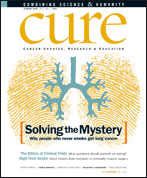Cord Blood: A Unique Banking Opportunity
Companies and public banks collect and store blood from the umbilical cord and placenta for stem cell transplants to treat blood disorders such as leukemia or lymphoma.
Patients can save their tumors, but should a mother save her child’s cord blood? Private companies offer, for a fee, to collect and store blood from the umbilical cord and placenta for future use in a sibling or relative who develops a blood disease, such as leukemia or lymphoma. Public banks allow women to donate the cord and placenta free of charge.
While stem cells—the parental cells that develop into different types of cells—transplanted from bone marrow have been standard treatment for certain cancers, researchers discovered stem cells retrieved from the blood of umbilical cords and placentas can be used in place of those taken from bone marrow, and may even be more useful.
While unrelated donor stem cells originating from bone marrow must match at least five of six antigens found on the surface of the blood (called human leukocyte antigen, or HLA), cord blood cells only need to match four, which means finding a match is more likely with stem cells of cord blood.
Because they have not developed immunologically, cord blood stem cells decrease the risk of graft-versus-host disease, a side effect of transplantation that causes the immune cells transplanted from the donor to attack the patient’s tissue. The wait time for transplantation may also be reduced with cord blood stem cells versus bone marrow stem cells, dropping to about two weeks compared with two months or more, respectively.
While more than 8,000 cord blood transplants have been performed so far around the world since the first was done in 1988, these transplants have primarily been performed on children since the number of stem cells in the umbilical cord is typically too low to treat most adults. But doctors are now combining cells from multiple donations to allow more adult patients to receive the treatment.
Experts say cancer survivors wondering if they should privately bank cord blood for their children as a precaution should know it’s unlikely it will be useful. Of the 400,000 cord blood units stored privately in the United States, only about 40 have been used for transplants. Even if a child develops a disease, the collected stem cells will probably be unusable since they likely also carry the disease. And cord blood stem cells don’t last forever—up to 10 years with current storing techniques.
Experts recommend donating cord blood cells to public banks—the more donations, the more likely patients will find a match. Indeed, the American Academy of Pediatrics says of the approximately 70,000 cord blood units donated to public banks, about 6,000 have been used for transplants.
Several private companies provide storage of cord blood for a one-time fee of about $1,500, and an annual fee of about $100. If banking is medically necessary, the expense may be covered under insurance, deducted from your federal income tax, or provided for free or at a discounted rate from a cord blood bank. Currently, about 25 private companies and about 25 public institutions collect cord blood.
The National Marrow Donor Program, a nonprofit that offers a registry of bone marrow donors, has a listing of cord blood donor banks at www.marrow.org. The organization’s Center for Cord Blood manages nearly 200,000 listings of cord blood units around the world.
